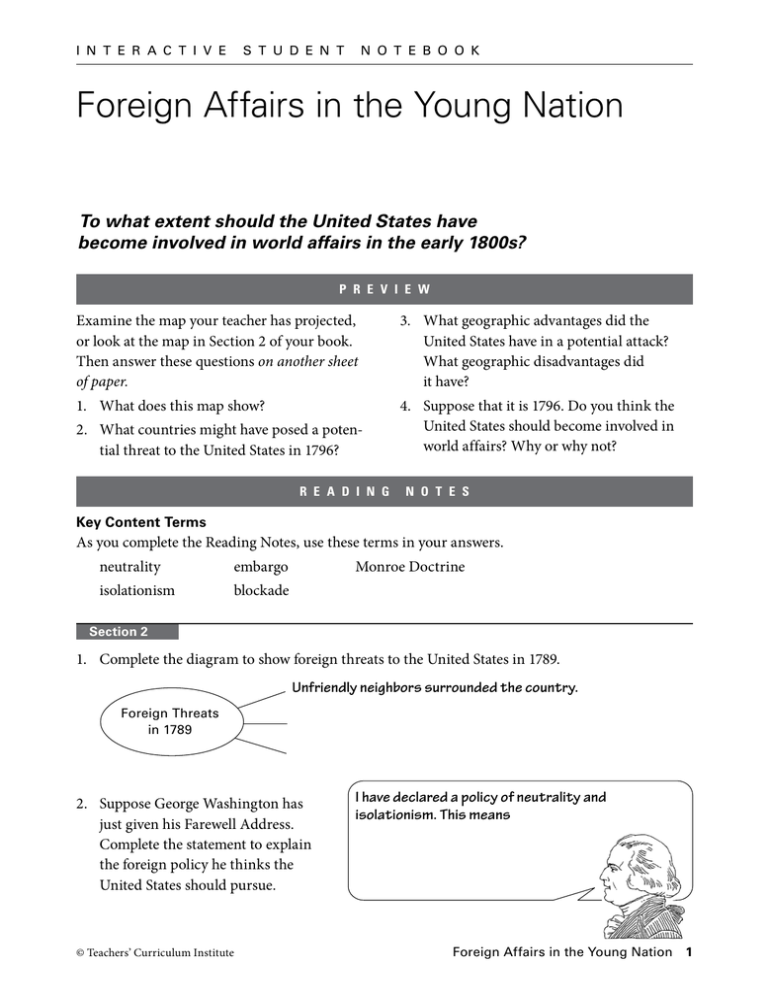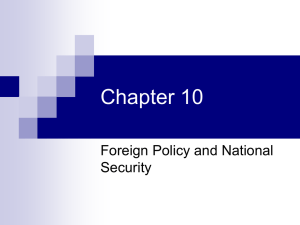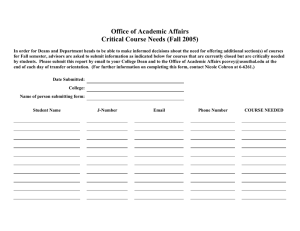Foreign Affairs in the Young Nation
advertisement

i n t e r a c t i v e s t u d e n t n o t e b o o k Foreign Affairs in the Young Nation To what extent should the United States have become involved in world affairs in the early 1800s? P R E V I E W Examine the map your teacher has projected, or look at the map in Section 2 of your book. Then answer these questions on another sheet of paper. 3. What geographic advantages did the United States have in a potential attack? What geographic disadvantages did it have? 1. What does this map show? 4. Suppose that it is 1796. Do you think the United States should become involved in world affairs? Why or why not? 2. What countries might have posed a potential threat to the United States in 1796? R E A D I N G N O T E S Key Content Terms As you complete the Reading Notes, use these terms in your answers. neutrality embargo isolationism blockade Monroe Doctrine Section 2 1. Complete the diagram to show foreign threats to the United States in 1789. Unfriendly neighbors surrounded the country. Foreign Threats in 1789 2. Suppose George Washington has just given his Farewell Address. Complete the statement to explain the foreign policy he thinks the United States should pursue. © Teachers’ Curriculum Institute I have declared a policy of neutrality and isolationism. This means Foreign Affairs in the Young Nation 1 i n t e r a c t i v e s t u d e n t n o t e b o o k Section 3 1. What did the Jay Treaty resolve? How did the French respond to the treaty? 2. Draw and label a simple illustration to represent the XYZ Affair. Then describe how Congress reacted to the incident. Section 4 1. Describe what President Adams did to protect U.S. ships in the Atlantic. Then explain whether you think he pursued the best foreign policy option. 2. Mark an X along the spectrum to indicate where President Adams’s response to attacks on U.S. ships falls. Then write a sentence explaining your placement. Isolationism © Teachers’ Curriculum Institute Total Involvement Foreign Affairs in the Young Nation 2 i n t e r a c t i v e s t u d e n t n o t e b o o k Section 5 1. Why did Great Britain impress U.S. sailors in the early 1800s? 2. Create a simple drawing to represent the problem of piracy by the Barbary States of North Africa. Then explain President Jefferson’s dilemma. Section 6 1. Describe how President Jefferson responded to piracy in the Mediterranean and to the continued seizures of ships by the British and French. Then explain whether you think he pursued the best foreign policy options. 2. Mark an X along the spectrum to indicate where President Jefferson’s response to piracy in the Mediterranean falls. Mark an O to indicate whether his response to seizures of U.S. ships by Great Britain and France reflected more isolationism or more involvement. Then write a sentence explaining your placements. Isolationism © Teachers’ Curriculum Institute Total Involvement Foreign Affairs in the Young Nation 3 i n t e r a c t i v e s t u d e n t n o t e b o o k Section 7 Complete the diagram to show the reasons why many Americans wanted to go to war with Great Britain in early 1812. impressment of sailors Reasons for going to war in 1812 Section 8 1. Complete the timeline of the War of 1812. For each month marked, briefly describe the event that happened and create a symbol to represent it. 1812 July 1813 September 1814 August 1815 December January © Teachers’ Curriculum Institute Foreign Affairs in the Young Nation 4 i n t e r a c t i v e s t u d e n t n o t e b o o k 2. Mark an X along the spectrum to indicate where President Madison’s decision to declare war on Great Britain falls. Then write a sentence justifying your placement. Isolationism Total Involvement Section 9 Why might the United States have been interested in supporting the new Latin American nations in the early 1800s? Section 10 1. In your own words, explain what the Monroe Doctrine said. Then explain whether you think President Monroe pursued the best foreign policy option. © Teachers’ Curriculum Institute Foreign Affairs in the Young Nation 5 i n t e r a c t i v e s t u d e n t n o t e b o o k 2. Mark an X along the spectrum to indicate where the Monroe Doctrine falls. Then write a sentence explaining your placement. Total Involvement Isolationism P R O C E S S I N G John Adams was so proud of avoiding war with France that he wanted that fact engraved on his tombstone. On a separate sheet of paper, create a tombstone like the one below for each of these presidents: George Washington (1732–1799) John Adams John Adams (1735–1826) 1735–1826 Thomas Jefferson (1743–1826) James Madison (1751–1836) James Monroe (1758–1831) He avoided war with France. He should have been more involved in world affairs because . . . Each tombstone should include • the years the president lived. • one example of how the president became involved in foreign affairs. • one sentence explaining to what extent you think the president should have been involved in world affairs. • a symbol representing the president’s foreign policy decisions. © Teachers’ Curriculum Institute Foreign Affairs in the Young Nation 6 i n t e r a c t i v e s t u d e n t n o t e b o o k R E A D I N G F U R T H E R Preparing to Write: Analyzing Motives “This Land Is Your Land” is a famous song by American folk singer Woody Guthrie. One line says that the land—the physical United States—was made for you and for me. Just who owns the land has been an ongoing question in our nation’s history. The Shawnee leader Tecumseh challenged both American Indians and the U.S. government on land ownership. According to Tecumseh, why should a tribe not sell land? Why did Tecumseh want to unite American Indian tribes? Why did Tecumseh refuse to retreat at the Battle of the Thames? Writing About Points of View White settlers and the U.S. government believed they had a right to buy land from American Indians. Tecumseh and his followers argued that the Indians did not have the right to sell the land. The two groups had different points of view. On the next page, you will write a statement about each point of view. Make sure your statements are free of spelling and grammar errors. © Teachers’ Curriculum Institute Foreign Affairs in the Young Nation 7 i n t e r a c t i v e s t u d e n t n o t e b o o k Write a short statement explaining the point of view of a white settler. Give supporting details for this point of view. Write another statement explaining the point of view of a follower of Tecumseh. Give supporting details for this point of view. Use this rubric to evaluate your statements. Make changes in your statements if you need to. Score Description 3 The statements have a clear point of view and supporting details. There are no spelling or grammar errors. 2 The statements have a point of view and some supporting details. There are some spelling or grammar errors. 1 The statements do not have a clear point of view or many details. There are many spelling or grammar errors. © Teachers’ Curriculum Institute Foreign Affairs in the Young Nation 8

